New York City Fusion II
I’m starting to collect photos of NYC restaurants that offer unlikely combinations of cuisines.
Where else can you get humus, naan and tabouli at the same time?
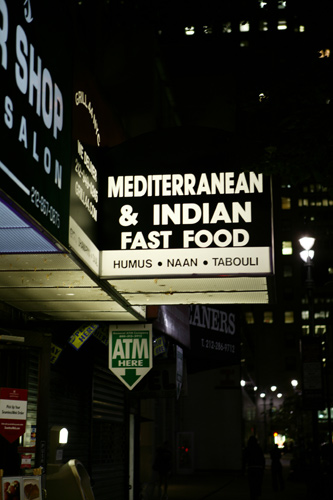
What’s the weirdest combination that you’ve seen?
Subway Style: 100 Years of Architecture & Design in the New York City Subway
October 2004 marks the 100th anniversary of the largest underground transit network in the world. Love it or hate it, if you’re a New Yorker, you can’t live without it: 3.5 million people ride the rails every day. The subway is as much a symbol of New York City as Central Park and the Statue of Liberty. Commemorating its centennial, this official publication presents an illustrated history of the architecture and design of the entire complex, from the interiors of the trains and the mosaic signage at the stations to the evolution of the token and the intricacy of the intertwined, rainbow-colored lines on the free, foldout map.
Produced with the New York City Transit Museum, Subway Style documents the aesthetic experience of the system through more than 250 exclusive pictures. The book includes newly commissioned color photographs of historic and contemporary station ornamentation as well as imagery from the Museum’s archives. The images span the full century, from the system’s inception in the early 1900s up to and including architectural renderings for the still-to-be-built Second Avenue line. AUTHOR BIO: The NEW YORK TRANSIT MUSEUM is one of only a handful of museums in the world dedicated to urban public transportation. The Museum’s collections of objects, documents, photographs, films, and historic rolling stock illustrate the story of mass transit’s critical role in the region’s economic and residential development since the beginning of the 20th century. The Transit Museum’s main facility is located in a decommissioned 1936 subway station in Brooklyn Heights, an ideal setting for the Museum’s 20 vintage subway and elevated cars, and wide-ranging educational programs for children and adults. A gallery annex in Grand Central Terminal presents changing exhibits relevant to the millions of commuters who use mass transit every day.
Photographer Andrew Garn has exhibited his work in galleries around New York City and across the country. His photographs are also held in numerous museum and private collections.
Bread and Circuses 3: Smelts and Westlake; Uni and Defoe
This is a third, and likely last article in which I pair up food with books. The previous two did not generate a single comment, but I still want to finish the series.
My third favorite cuisine is Japanese. The best Japanese cooking is about the ingredients. Think about it: sashimi is basically sliced up raw fish. It’s an ingredient with the least preparation possible. Yet it’s one of the tastiest things ever, if the fish is good and the chef sliced it well. Simplicity and lightness, that’s what I like about Japanese food. I’ve picked two of my favorite dishes, a fried fish and sea cucumber roe, and paired it up with two simple light reading book series.
My father grew up on Sakhalin island, a place where salmon and even sturgeon roe were dirt cheap and widely available. Kids would thumb their noses at their caviar and smoked fish, my dad said. But there was one fish still highly prized. A humble smelt. Easily caught, it was usually full of delicious roe. Fried – the tastiest thing ever. While fresh, interestingly enough, smelts smell like fresh cucumbers. I first tasted a fried smelt in a Japanese restaurant Yakitori East, one of the few places in New York that serves them. They are also available in Japanese and Korean supermarkets, I’ve bought and fried them at home many times.
Fried smelts are just as addictive as books from the Dortmunder series by Donalde E. Westlake. These are masterpieces of a particular subset of subset of crime fiction genre: a comical caper story. You get too root for a band of bumbling crooks led by John Archibald Dortmunder, a very competent, but extremely unlucky master thief with a beer-inspired last name.
You know how the two Alice stories have a chess game and a card game theme? Well, Dortmunder stories can be thought of as games of American football. The characters are highly specialized, just like football players, they face constant fumbles and setbacks, but from time to time they get to score. In fact, if I remember correctly, one of Dortmunder books even has chapters based on football: “First down”, and so on to more downs than there are in game rules.
Dortmunder’s core crew includes an all-purpose crook Andy Kelp, a thuggery specialist Tiny Bulcher, a getaway driver obsessed with New York City traffic patterns Stan Murch. Kelp and Dortmunder can pick locks, but when the job calls for it experts are called in. So are extra drivers, computer experts, and other colorful characters. Everybody except Stan Murch has long time girlfriends who take part in criminal acts from time to time. Stan’s cab-driving Mom known as “Murch’s mom” is a frequent cast member.
The now-canceled Firefly tv series is definitely inspired by the Dortmunder stories: as a nod, Joss Whedon named one of the big Alliance ships IAV Dortmunder.
There’s something amazingly likable about a competent, but unlucky master thief with a hang-dog look about him. I, for some reason deeply identify with Dortmunder. On the other hand, in real life I’m probably more of Arnie Albright, the friendless and obnoxious (and aware of it) fence. Arnie’s so obnoxious that nobody willingly deals with him (unless they have to). Dortmunder would much prefer dealing with another fence, Stoon who’s unreliable and pays much less.
I’ve read every single Dortmunder book there is. Westlake is currently working on the next installment in which the gang participates in a reality show.
***
Uni is a simple dish. Well, it’s not much of a dish. It’s sea urchin’s roe. You just dunk it in soy sauce and eat it. Uni had amazing taste: creamy, briny,sweet, custardy. If you watched Iron Chef at all, you probably spent hours listening to the judges rave about uni.
What would go great with uni? Gideon Defoe’s Pirates! books. What are they about? Well, they are about oh, only the most important things in the world. Ham. Piracy. Marine mammals. Science, Philosophy, Love. Sea shanties. Ham.
The nameless Pirate Captain leads a large group of child-like pirates and Cutlass Liz through most amazing adventures. His evil rival Black Bellamy constantly defeats an humiliates him and his crew, but the Pirate Captain does not like to dwell on that.
If I were to trust what I’ve read on the Internet, Pirates! was written to impress a girl to leave her boyfriend (which she didn’t). Defoe also is somehow related to Daniel Defoe.
There are three books out:
[amazon cover 0375423214]
[amazon title 0375423214]
[amazon cover 0375423850]
[amazon title 0375423850]
[amazon cover 0375423974]
[amazon title 0375423974]
According to Gideon’s livejournal, The Pirates! In An Adventure With Napoleon is already out. Also he’s working with Aardman on a Pirates! cartoon.
New York City Fusion
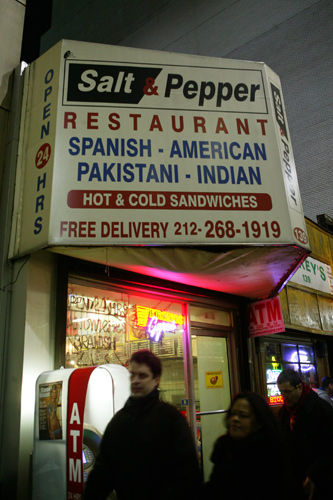
New York City has some of the most interesting cuisine mixes. Spanish – American – Pakistani – Indian – there’s fusion for you.
The Anatomy of a NYC Parade
New York City is well known for two types of public celebrations: New Year’s Eve in Time Square and Ticker-Tape parades.
New York City streets are like a 300 pound person in McDonalds: it seems that his or her arteries are so clogged with cholesterol that it’s impossible to clog them any more. Watching NYC streets during a celebration it’s like watching Homer Simpson eat 100 ribwiches. But New York City’s Finest and Strongest have crowd control down to a science, and people and garbage clots get dislodged very fast.
There are three major groups in an NYC public celebration: tourists, local shmoes, pros, and those who work there. Four major groups.
Let’s take a look at the following picture that I took out of my new workplace during the ticker tape parade thrown for the New York Giants.
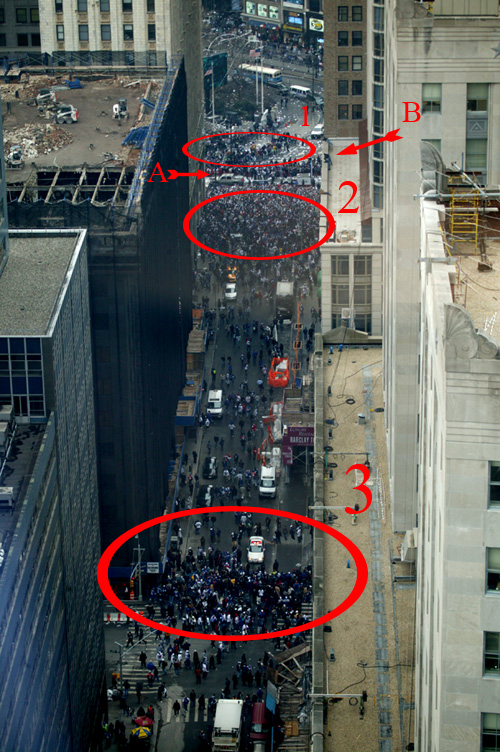
Arrow with the letter A points to the actual parade: a float with football players going down the Canyon of Heroes. Number 1 denotes the group that came prepared and staked out spots right along the parade path. These are the pros: the showed up long before NYPD blocked the exits and stuck it out for the next several hours. Group number 2 is the clueless parade goers who showed up late, had to walk for a dozen of blocks that were blocked by police looking for a way to get closer to the parade, finally giving up and standing shoulder to shoulder in a humongous mass of people. They can’t see anything interesting.
During New Year’s eve this group is held in place by mounted policemen who, believe it or not pack the crowd in by backing their horses in sideways.
Group number 3 is all the people looking for a path to get into group 2 and those who are late for work and are trying to see a break in the police barricade.
Arrow B points to a more civilized way to enjoy the parade, but it required employment in one of the building next to a celebration.
NYC celebrations remind me of the Soviet times and the May Day parades. The trick was to leave from about 3/4 from the end of the parade, otherwise you reached a fenced in area and could not leave for hours having to listen to communist functionaries giving speech after speech.
I have some advice for those who want to enjoy a ticker tape parade or an NYE celebration in Manhattan:
- Reconsider: you will be crowded by people on all ends and freezing cold for hours. Definitely reconsider if you are claustrophobic, germophobic, have a weak bladder, or don’t like to come into contact with police horse’s ass.
- Show up before the cops block the street. This means at least 3 hours before the start. The best way to do so is to find a restaurant and spend your time there: remember – it will likely be cold.
- If you are a bit late, your best bet is getting out of a subway station right on the parade’s path: these get blocked off pretty late.
- Have a meal somewhere nearby and show up when most of the people left and the cleanup crews have arrived: this is usually more fun than the main event: you can take all the pictures and watch tons of confetti and garbage cleaned up in a matter of minutes.
- Do not reach out with your hand and scratch police horse’s ass. Just believe me on this one.
Stigma and the City
New York is like a hot girl in high school. One that’s easy to love, easy to hate, and easy to pretend that you don’t care about at all (since she does not notice you anyway). New York is beautiful, ugly, cruel and kind — all at the same time. They are both high maintenance and high rent.
My high school experience was surprisingly non-traumatic. I never tried to pretend to be someone I’m not, to hide my geekiness and foreignness. Strangely enough that made me feel like I actually fit in, even though I probably did not. And while I “missed my chance” in high school, my love affair with New York City is going strong.
Side Note: my high school’s only famous alumni is Larry David, creator of Seinfeld and the inspiration for the character of George Costanza.
Tourists to New Yorkers are what geeks and nerds are to jocks. This highly insensitive sign in front of the currently inaccessible to the public lobby of the Woolworth Building.

I spent the last 14 years in New York, but to this day I have not lost the feeling of being a tourist. I constantly carry a brick of a camera with me (mostly in my bag, but often on a strap around my neck) and gawk at the skyscrapers. Most of my co-workers avoid Times Square like the plague because of all the slow moving tourists. I, on the other hand, feel at home there.
If the tourist is the lowest of New York’s inhabitants, there’s even more gradation. New York is not just Manhattan. There are 4 other boroughs plus Long Island and New Jersey, denizens of which can only reach Manhattan via a bridge or a tunnel and are collectively known as “the bridge and tunnel crowd” . The moniker is not precise — there are four other ways to reach the city the I know of: ferry, water taxi, helicopter taxi, and Roosevelt Island Tram. I am a proud bridge and tunneler as well.
One of my first jobs in Brooklyn was circular delivery — those annoying little advertisement newspapers that you find wedged into your door or mailbox. I spent a lot of time methodically crisscrossing Brooklyn’s street grid, visiting many different neighborhoods. I used to mark the street map that I visited to make sure that I covered the area that I was supposed to cover. I wonder if they use GPS to insure that the delivery men cover their area now. There are few things that I like more than walking Manhattan’s streets, watching people and arhitecture and taking pictures.
I am thinking of two projects. First – visiting every single street in Manhattan with the help of GPS. I believe that this was done already, as well as my ongoing (but mostly unpublished NYC Tarot photography project). But secondly, I want to take a series of photographs from the middle of Manhattan’s street intersections – there’s something about the view of NYC’s streets from the intersections that fascinates me, and it’s a view that few people explore.
Unlucky Luciano
” ‘I feel you’re being a little harsh on your more eccentric callers.’
‘Of the Howardly persuasion?’
‘Precisely. You undervalue them. Viruses in cashew nuts, visual organs in trees, subversive bus drivers waving secret messages to one another as they pass, impending collisions with celestial bodies. Citizens like Howard are the dreams and shadows that a city forges when it awakes. They are purer than I.'”
Luisa Rey on the Bat Segundo’s show in David Mitchell’s “Ghostwritten”
One of the skills that you learn as a New Yorker is tuning out the mentally ill or simply obnoxious people, with cell phone headsets or without, who constantly assault your hearing. As tuning out a subway preacher who constantly modulates her voice is next to impossible, I usually carry a pair of earplugs in my bag.
Yesterday, as I was riding the Brighton line while reading an interesting book, a man sitting a couple of seats from me began ranting. Looking like Isaak Asimov in his later years, but more disheveled, the dude had a voice of a PBS announcer. A couple of minutes into the rant, I suddenly realized that he was talking about something rather familiar to me — the history of the BMT and BRT, and the Malbone Street Wreck in particular.
The Malbone Street Wreck was the worst subway disaster in New York’s history. 93 people perished in a horrible crash caused by Edward Luciano, a crew dispatcher pressed into service as a motorman during a subway strike. He hit an S-curve designed for 6mph at 30mph. I happened in 1918, when the trains were still made out of wood and there were only 4 cars in a train. The first and fourth cars survived the crash mostly intact, but the middle two cars derailed and slammed into a tunnel wall under Malbone street.
As the unwelcome subway tour guide was pointing out, we were passing by what used to be Malbone Street, but is now called Empire Boulevard. The street was renamed because of the accident, kind of to dim the memory of the crash. What is even more disturbing, there is no memorial at the station where this happened. Well, at least I don’t remember seeing one.
All these years I mistakenly thought that the crash happened somewhere on the 2 line, nearer to Brooklyn College. I guess it took a disturbed man’s rant to set me straight on the matter.
In New York City we pass through places where horrible tragedies happened. My wife had classes at what is now known as the Brown Building of Science. I spend a lot of time fishing at a place where 10 illegal immigrants drowned trying to reach the shore in the Golden Venture incident. There’s a place in the Empire State Building where a B-25 bomber crashed into it, killing 11 people. I still shop at the Staples store that was built in place of a Waldbaums supermarket where 6 firemen perished. And everybody knows what the horrible emptiness in New York’s skyline means.
The fabric of the city closes around disasters, some sooner than others. But the ghosts will not let you forget them. They still lurk in the shadows, whisper their stories to you as you pass by. As the subway ranter finished his rant, a young man wearing a hoodie with a Donny Darko-like skeleton on it sat down next to him. I took a picture of the two of them with my Treo, but all of my Treo photos got destroyed during the software update that I did today.
The Nutcracker Season
This holiday season finds me once again working in the Rockefeller Center. This time I am in the building with the funny neon sign.
Most of the lesser Rockefeller Center buildings put up gaudy X-mas decorations up front: a giant present box, a huge mound of ornaments, and a scary animatronic jack-in-the-box riding a train. My building has giant nutcracker statues.
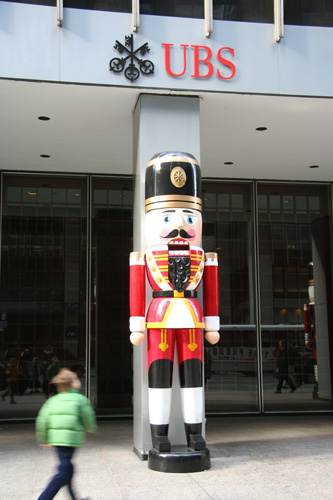
While giant copies of their CO stand outside, in the lobby a trio of toy soldiers sing carols and gesticulate. They seem to be enjoying themselves, well, as much as three costumed men in makeup can enjoy singing carols to an endless procession of salarymen, suits, techies, administrative assistants and other denizens of corporate America.
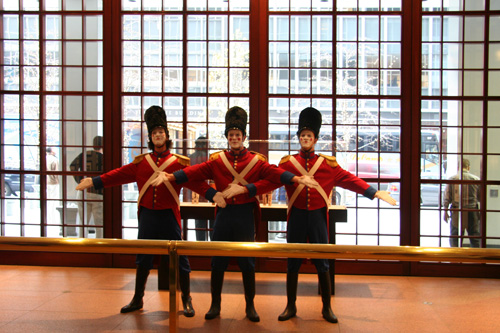
I, for one, is very thankful for a pleasant and interesting new gig and many exciting opportunities, but my thoughts are with those in terrible jobs. Those of you who aren’t happy – there’s always the Internets with wonderful sites like the Joel on Software job board.
Still, those of you who think that you are unhappy, I’d like to leave you with a haiku that I made by lightly editing a very real lament of a Burger King worker that I found on Livejournal’s bkstories community. I count BK as one syllable, not two which is probably wrong.
Holiday season.
I work at BK near Walmart.
Shoot me in the face.
De gustibus non est disputandum
In the former Soviet Union, cognac was the expensive booze of choice, while whiskey was relatively unknown. Technically, you can only call cognac the brandy from Cognac in France, but the Soviets did not care much about that, already abusing Appellation d’Origine Contrôlée with Soviet Champagne.
In any case, high end Armenian brandy was considered the ultimate drink. Armenians were one of the first to invent the alcohol distilling technology, and Armenian brandy, by the way was the very same drink that Odysseus used to knock out the Cyclops.
The reason I remembered all this, is because two news articles reminded me of a Russian saying: to a pessimist cognac smells like bedbugs, to an optimist – bedbugs smell like cognac. Good cognac has a rather peculiar smell, and some say that it smells exactly like squashed bedbugs. Although I smelled cognac often enough, I’ve never smelled squashed bedbugs. Thus I can’t really say if the saying is true, or just an artifact of crappy Soviet cognac.
Consider the contrasts:
In Zimbabwe people are eating rats:
“Twelve-year-old Beatrice returns from the fields with small animals she’s caught for dinner.
Her mother, Elizabeth, prepares the meat and cooks it on a grill made of three stones supporting a wood fire. It’s just enough food, she says, to feed her starving family of six.
Tonight, they dine on rats.
“Look what we’ve been reduced to eating?” she said. “How can my children eat rats in a country that used to export food? This is a tragedy.””
Zimbabwe’s ambassador to United States, Machivenyika Mapuranga, told CNN on Tuesday that reports of people eating rats unfairly represented the situation, adding that at times while he grew up his family ate rodents.
“The eating of the field mice — Zimbabweans do that. It is a delicacy,” he said. “It is misleading to portray the eating of field mice as an act of desperation. It is not.” “
It’s hard to be optimistic about rat eating, but I guess it’s not as difficult for Mr. Mapuranga.
On the other hand, it’s probably pretty hard to be pessimistic about gourmet food served in some Manhattan soup kitchens:
“The multicourse lunch that Michael Ennes cooked in the basement of Broadway Presbyterian Church last week started with a light soup of savoy and napa cabbages. The endive salad was dressed with basil vinaigrette. For the main course, Mr. Ennes simmered New Jersey bison in wine and stock flavored with fennel and thickened with olive oil roux.
But some diners thought the bison was a little tough, and the menu discordant.
“He’s good, but sometimes I think the experimentation gets in the way of good taste,” said Jose Terrero, 54. Last year, Mr. Terrero made a series of what he called inappropriate financial decisions, including not paying his rent. He now sleeps at a shelter. He has eaten at several New York City soup kitchens, and highly recommends Mr. Ennes’s food.”
The gourmet soup kitchen chef is an optimist though:
“Despite the care he puts into his cooking, he doesn’t mind a little criticism.
“They’re still customers, whether they’re paying $100 a plate or nothing,” Mr. Ennes said. “One thing we do here is listen to people and let them complain. Where else can a homeless person get someone to listen to them?” “
I grew up with the Soviet media feeding me horror stories about life in America, and I know that indeed, looking at the world through the eyes of reporters is “looking through a glass darkly“. I trust the CNN reporter over the Zimbabwian politician because the latter has a much keener interest in misrepresenting the reality. But on the other hand, the efforts of the New York Times reporter to find the several homeless critiquing the free gourmet cuisine seem a little artificial. I bet 99% of them were rather grateful for tasty meals. But then, I don’t doubt that the New York City homeless can be rather picky — I’ve seen some refusing and even throwing offered food at the would be Good Samaritans.